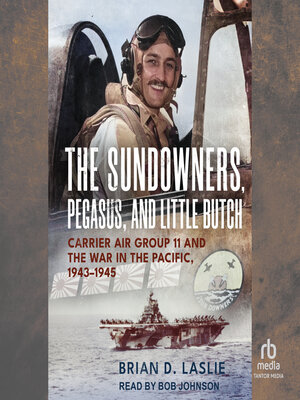The Sundowners, Pegasus, and Little Butch
audiobook (Unabridged) ∣ Carrier Air Group 11 and the War in the Pacific, 1943-1945
By Brian D. Laslie

Sign up to save your library
With an OverDrive account, you can save your favorite libraries for at-a-glance information about availability. Find out more about OverDrive accounts.
Find this title in Libby, the library reading app by OverDrive.



Search for a digital library with this title
Title found at these libraries:
| Library Name | Distance |
|---|---|
| Loading... |
The Sundowners, Pegasus, and Little Butch provides a new perspective on the Pacific War by following the exploits of a single Navy unit, Carrier Air Group 11 (CVG-11), beginning in 1943. Author Brian D. Laslie tells the riveting story of how the unit produced several aces, built a storied combat record, and played an important role in the defeat of Japan.
Like other Carrier Air Groups, CVG-11 comprised three aircraft squadrons: fighter (VF-11), bomber (VB-11), and torpedo (VT-11). CVG-11 saw its first action on Guadalcanal in 1943. It was then deployed on the aircraft carrier USS Hornet (CV 12) and fought throughout the Central and Southwest Pacific areas, from 1944 to 1945. The air group's achievements during World War II were laudable, amassing 103 air-to-air victories, destroying 272 grounded planes, and sinking more than 100,000 tons of Japanese shipping. During its time on the Hornet, CVG-11 also produced four aces, with top ace Charlie Stimpson shooting down an impressive sixteen enemy planes. VF-11 took great pride in protecting their shipmates and other squadron members in VB-11 and VT-11 and logged a perfect escort record, losing no bombers or torpedo planes to Japanese aircraft during the entire conflict. Laslie weaves together diaries, interviews, archival research, and official battle reports to present CVG-11's compelling story.
Like other Carrier Air Groups, CVG-11 comprised three aircraft squadrons: fighter (VF-11), bomber (VB-11), and torpedo (VT-11). CVG-11 saw its first action on Guadalcanal in 1943. It was then deployed on the aircraft carrier USS Hornet (CV 12) and fought throughout the Central and Southwest Pacific areas, from 1944 to 1945. The air group's achievements during World War II were laudable, amassing 103 air-to-air victories, destroying 272 grounded planes, and sinking more than 100,000 tons of Japanese shipping. During its time on the Hornet, CVG-11 also produced four aces, with top ace Charlie Stimpson shooting down an impressive sixteen enemy planes. VF-11 took great pride in protecting their shipmates and other squadron members in VB-11 and VT-11 and logged a perfect escort record, losing no bombers or torpedo planes to Japanese aircraft during the entire conflict. Laslie weaves together diaries, interviews, archival research, and official battle reports to present CVG-11's compelling story.







